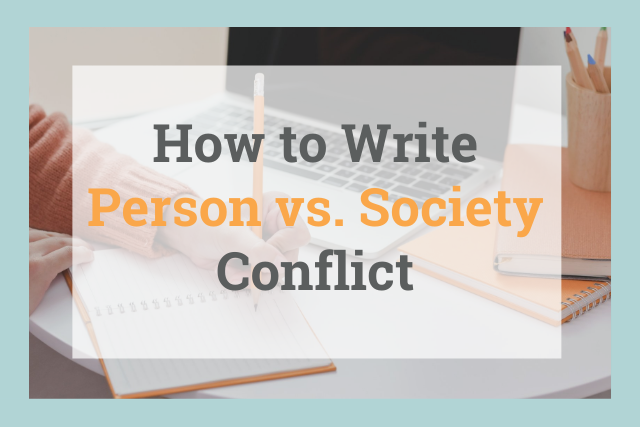
Great stories often challenge our thoughts about society and the world. Some stories provide warnings about where society is headed while others offer social criticism about our current world.
These stories usually feature person vs. society conflicts, where the main character is in direct conflict with society.
Some of the greatest books of all time use person vs. society as their main conflicts. Here’s everything you need to know to craft an excellent story with this conflict.
What Is Person vs. Society Conflict?
A person vs. society conflict is when the main character or characters of a story are in direct conflict with society. You can’t fight a society with a sword, so what does direct conflict mean?
Person vs. society (also known as character vs. society) conflicts have aspects of society or society as a whole as the root of all the other conflicts in the story. There might be a fate conflict, character conflict, or internal self conflict that drives the plot. But those elements are either caused by society or represent society.
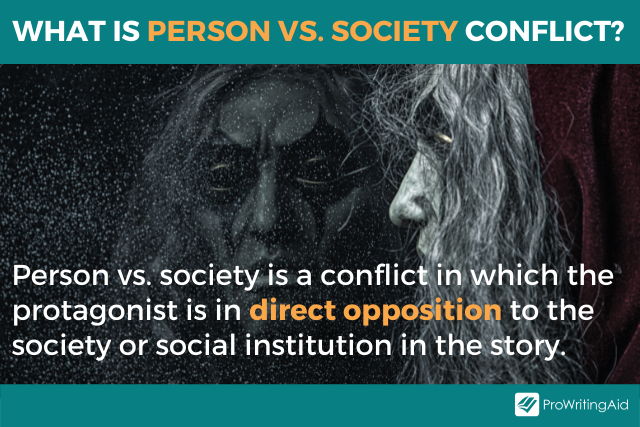
A common type of story that often features a person vs. society conflict is dystopian literature. In dystopian stories, the protagonist acts against society in some way. They might rebel or even start a rebellion, like in the Divergent series.
They might try to escape the dystopian society like in Anthem by Ayn Rand. Usually, the person vs. society conflict shows the dangers of authoritarianism, power, and control.
But this conflict type is not limited to dystopian books and movies. Any sort of story can feature person vs. society conflict. We’ll take a look at some examples later in this article.
It’s important to note that various sources use the terms man vs. society conflict, as well as character vs. society or individual vs. society. They all mean the same thing. For this article, we will use these terms interchangeably.
Is Person vs. Society an External Conflict or Internal Conflict?
It might be hard to determine whether character vs. society conflict is an example of external or internal conflict. Often, the novel’s main character struggles against some sort of person vs. self conflict in order to challenge society. Additionally, society isn’t a tangible concept.
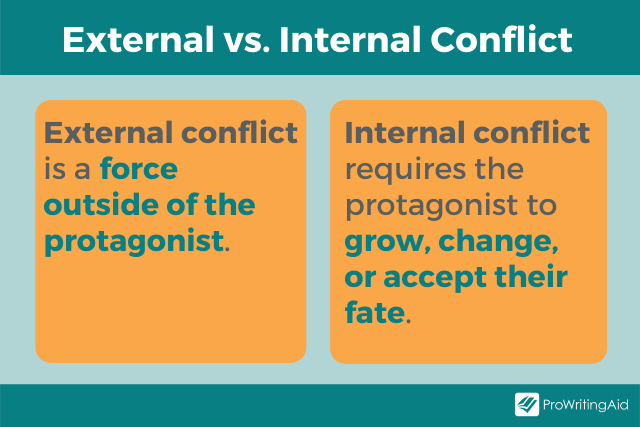
However, because society is something larger than one person and exists outside of the individual, man vs. society is a type of external conflict.
The other types of external conflict in stories are man vs. man, man vs. nature, man vs. technology, and man vs. supernatural. Internal conflict is limited to man vs. self and man vs. fate.
As mentioned in a previous section, character vs. society is usually not the only conflict present in a story.
Other types of conflict are used to progress the plot and illustrate themes. However, the overarching message will relate to whatever the society conflict is in the story.
What Themes Are Common in Man vs. Society Conflicts?
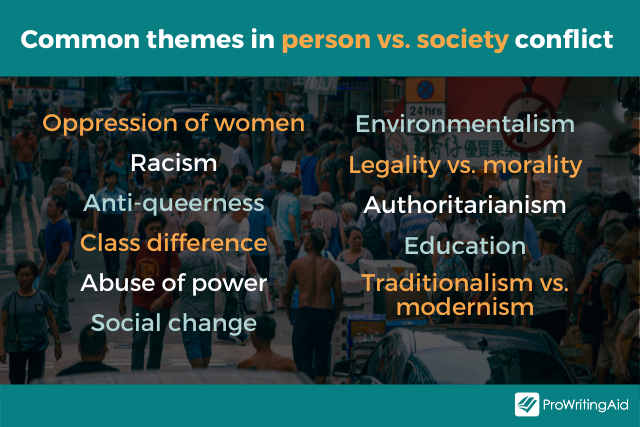
Stories with man vs. society conflicts tackle some heavy themes. Dystopian literature and historical fiction often deal with oppressive governments, legality vs. morality, and critiques of specific economic or political systems.
Criticisms of religion or religious dogma are also frequently explored themes in stories dealing with this kind of conflict. In fact, these stories can get downright philosophical.
Here are some other common themes that might be explored in this type of external conflict:
- oppression of women
- racism
- anti-queerness
- class differences or class mobility
- othering for deviance
- abuse of power
- finding acceptance
- social change and evolution
- power of knowledge or education
- environmentalism
- traditionalism vs. modernism
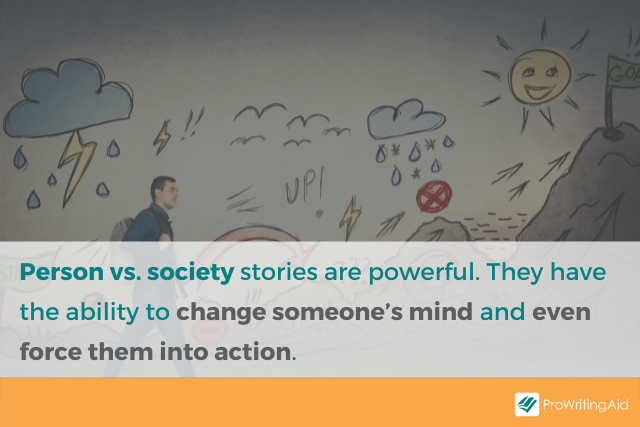
We all have strong values, and many of our beliefs differ from what a portion of society says is acceptable. These beliefs are why we keep reading and watching stories with these conflicts. Character vs. society stories are powerful. They have the ability to change someone’s mind and even force them into action.
How Do I Write a Character vs. Society Story?
Writing a story with a person vs. society conflict might seem daunting. There’s no right or wrong way to go about it, but I have outlined some suggestions for planning your story.
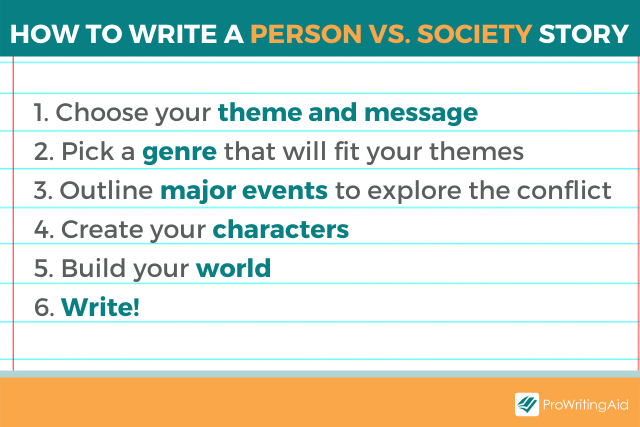
Start with Your Theme
First, choose your theme or the aspect of society you want to critique. There might be more than one, but they should be related or easy to connect through your novel.
Choose Your Genre
Then you can figure out how you want to explore these themes. You’ll need to choose a genre or general story structure. Any genre can lend itself to this type of conflict, but not all genres will work with the message you want to portray.
If you’re writing a romance novel, for instance, you probably won’t be writing a dystopian story about characters rebelling against a tyrannical government.
You may, however, be writing a story about societal norms and pressures that force characters in and out of relationships.
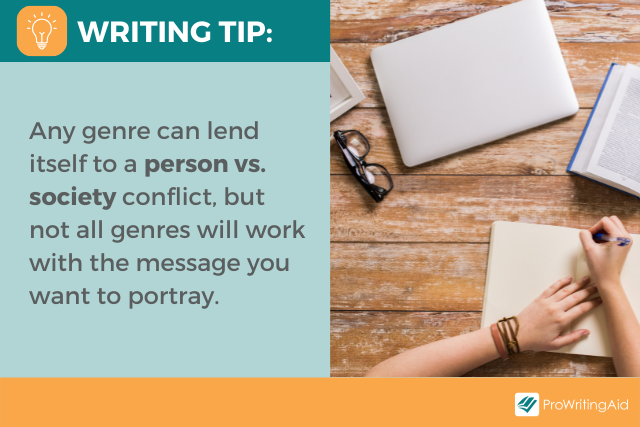
How Do I Choose the POV for My Novel?
Man vs. society stories can be written from any point of view (POV).
You might choose to use the first person to help your reader get into your main character’s mind. Or, you could use the third person to show the wider effects of the conflict beyond your character’s world.
The most important thing to remember is to avoid hopping between perspectives. Pick your POV, then stay consistent.
Plan Your Novel
Outline any major ideas you have for exploring the society conflict in your story. Then develop your characters and your world. You can also figure out what other types of conflict you’ll feature in your story. Will there be a man vs. man conflict? Will your protagonist face an internal conflict?
Once you have a general idea of your theme and conflict, you can get ready to write.
What are Some Examples of Character vs. Society?
It’s hard to narrow down character vs. society examples as this conflict type is so prevalent throughout history. We’ve picked a few great books and movies that feature these philosophical external conflicts in an exciting or memorable way.
What are Some Character vs. Society Books?
We’ve chosen some person versus society examples from classic literature. Can you think of any more modern examples?
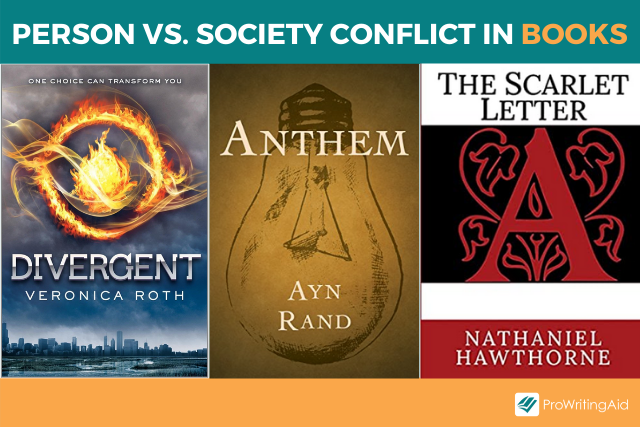
The Scarlet Letter by Nathaniel Hawthorne
Hawthorne’s literary classic is a quintessential example of character vs. society. Hester Prynne is a woman who commits adultery which results in her bearing a child.
She is forced to wear a red A on her so everyone knows she sinned and broke the law. She is an outcast who must repent, but she struggles to live the life her society expects her to. This work explores the ideas of religious control, sex as sin, and guilt.
It highlights how society uses shame and stigmatization as a means of social control, and how in the end it serves no one. Other conflicts are explored, as well. There are man vs. man conflicts, as well as a tragic person vs. self conflict where Dimmesdale literally gets sick and dies from guilt.
Cry, the Beloved Country by Alan Paton
In this South African novel, Reverend Kumalo is a Zulu priest who is forced to navigate the racist social structures that have forced the breakdown of tribal systems and forced the Black South Africans into crime and poverty out of necessity. Kumalo finds that his son and his sister have fallen into tragic lives when they move to the big city.
It’s less a social commentary and more a protest against racism. The book takes place in the years before Apartheid and explores the social structures that allowed Apartheid to take hold.
Fahrenheit 451 by Ray Bradbury
There are many great dystopian classics, but Fahrenheit 451 by Ray Bradbury is one of the most popular. It takes place in a future where books are banned. People who have books are enemies of the state, and their homes are burned by firemen.
A fireman named Montag steals a book and begins to question everything society has told him. He ends up surviving a nuclear war along with other readers who escaped.
The story ends on an optimistic note. The conflict shows the dangers of censorship and how mass media encourages conformity and discourages free thinking.
It might be a bit daunting to include conflict between your protagonist and society in your own stories, but seeing how you stack up against authors who use this dynamic can help.
ProWritingAid’s author comparison feature allows you to select your favorite author and compare their writing to yours in a number of areas like dialogue tags, emotional tells, sentence structure, and more.
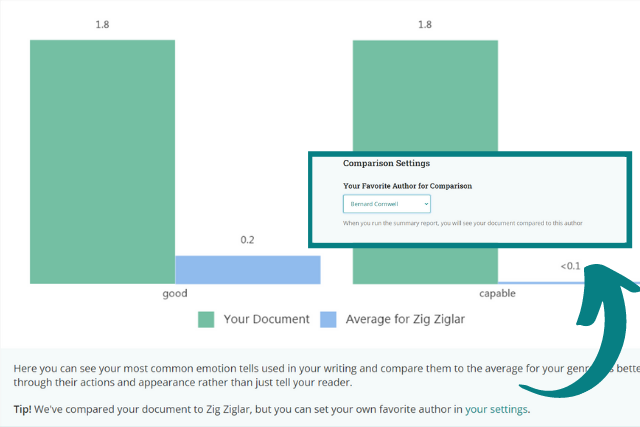
Try the author comparison feature with a free ProWritingAid account.
What Movies Have a Character vs. Society Conflict?
There are some incredible blockbuster movies that feature conflicts between a character and society. Here are a few examples.
Edward Scissorhands (dir. Tim Burton)
You might not think of Edward Scissorhands as anything more than a Tim Burton classic, but it’s also a classic character vs. society conflict.
Edward is a boy who is created by a scientist, but his maker dies before he can finish his hands. Edward is discovered living in isolation by a sweet, well-meaning Avon lady who takes him into her home.
At first, the people of this suburban town are fascinated by Edward, and they take advantage of his innocence, kindness, and unusual skills. But when Edward no longer serves a purpose, they turn on him quickly, making him into a villain and running him out of their society.
It’s an exploration of conformity and othering and highlights how people will only accept deviance from the norm while it serves them.
Footloose (dir. Herbert Ross)
Footloose doesn’t just have a dancing Kevin Bacon and a killer soundtrack. Ren is a city-raised rebel without a cause who moves to a small town that has banned all dancing and rock music, believing they are sins.
He introduces his friends to dancing, which causes outrage in the small, religious town. The movie explores the age-old conflict of tradition vs. modern and highlights the importance of freedom of expression.

Remember the Titans (dir. Boaz Yakin)
Stories with social conflicts are often grounded in reality, as many people have fought to change society throughout history. Remember the Titans is based on the life of Herman Boone, a Black high school football coach who helped integrate a football team in 1971 Virginia.
The white population of the town are vehemently opposed to integration, which is required by law. But Boone inspires his teenage football players to come together and break racial barriers. This leads to more acceptance in the town. Boone faces threats against his family, violence, and scandal.
Movies and books that explore civil rights and human rights are some of the most powerful stories that we have.
Why Should You Use Person vs. Society Conflict?
The best character vs. society stories force us to look inward at our own complicity in social problems and outward at the world we’ve always known. They can inspire us to change our thoughts, values, and viewpoints, which in turn can change the world.
We look forward to seeing what person vs. society conflicts you can tackle in your writing.


